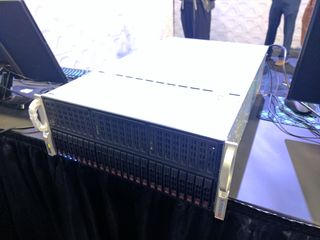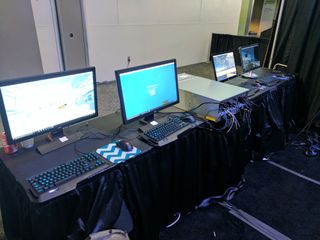AVADirect Seeks Limits Of Multi-User VR Systems At GTC

We stopped by AVADirect’s booth at Nvidia’s annual GPU Technology Conference (GTC) to see the company's implementation of multi-user virtual reality (VR) in action.
Nvidia showcased its own multi-user VR system early in the week, powered by four Quadro P6000 GPUs. AVADirect, which frequents our pages in the role of a custom shop system builder, also serves the commercial and government space, and we were surprised to see its large multi-user VR system powering four VR HMDs. However, instead of a quartet of P6000s, AVADirect used three P5000 GPUs and a single P6000 to feed the virtual workstations (with each GPU assigned to its own VM).
The monstrous system is housed in a 4U rackmount chassis and features not one, but two Intel Xeon E5-2640 v2 CPUs seated on a dual-socket SuperMicro motherboard. Each CPU gets 64GB (4 x 16GB) of DDR4-2400 ECC, for a total of 128GB of memory. Storage is similarly obscene. Although a 256GB Samsung 850 Pro 2.5” SATA SSD hosts the main operating system, each VM gets its own 1TB Samsung 850 Pro SSD, for a total of 4TB.

The system supports four individual HTC Vive headsets that were set up within the same play space (Lighthouses) for standing/stationary demonstrations (no room scale). This is achieved by creating a virtual machine (VM) for each of the headsets and allocating memory and CPU resources, in addition to a dedicated GPU and storage device, to that VM. However, AVADirect made it clear the company was on a mission with this massive endeavor.
“We’re exploring the capabilities of the multi-user VR platform to discover its limitations,” said Shannon Robb, marketing director at AVADirect. “We’re seeing how many VM clients can run stably on a single GPU and testing different combinations of GPUs in an effort to determine the best set of hardware for each use case at multiple price points. The platform is completely scalable, and we’ll find the sweet spots for the task at hand.”
Although we won’t be seeing any consumer-grade multi-user VR machines anytime soon, these innovations will soon make it possible for commercial VR installations to reduce their footprint with fewer systems that support multiple users.
| Processors | Intel Xeon E5-2640 v2 x2 |
|---|---|
| Memory | 128GB (4 x 16GB per CPU) DDR4-2400 ECC |
| Storage | - 256GB Samsung 850 Pro SSD (Boot Drive)- 1TB Samsung 850 Pro SSD x4 (One per OS) |
| Graphics | - Nvidia Quadro P5000 x3- Nvidia Quadro P6000 x1 |
Stay on the Cutting Edge
Join the experts who read Tom's Hardware for the inside track on enthusiast PC tech news — and have for over 25 years. We'll send breaking news and in-depth reviews of CPUs, GPUs, AI, maker hardware and more straight to your inbox.
-
derekullo Not only can it play Crysis but it can make you defecate yourself while playing Crysis.Reply
Most Popular


